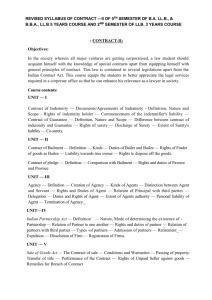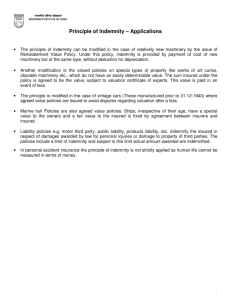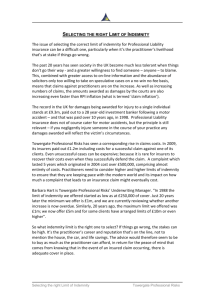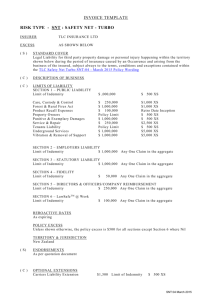Construction Engineering 380 Indemnification, Sureties, and Bonding
advertisement
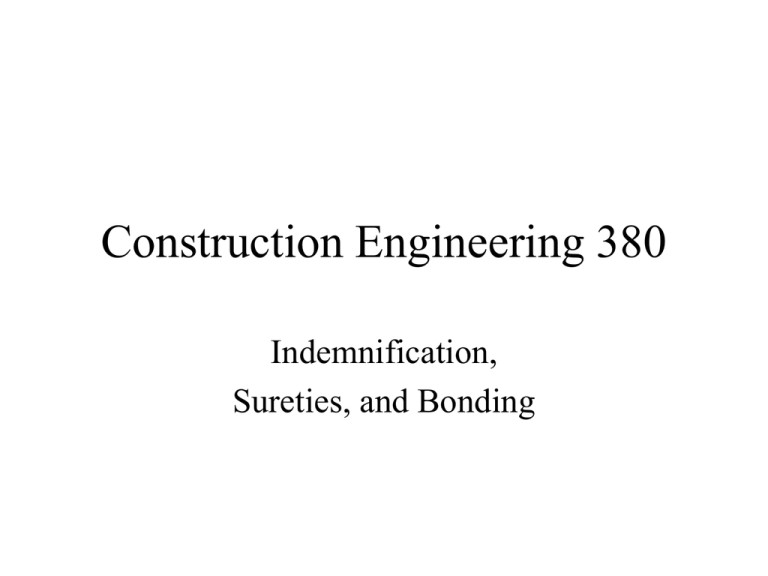
Construction Engineering 380 Indemnification, Sureties, and Bonding Indemnification • Can have varying “degrees” of responsibility (liability) – – – – – First instance vs. ultimate Passive s. active Primary vs. secondary Contractual vs. non-contractual Courts and the industry try to keep all liability and indemnification cases as contract (not tort) Indemnification • Purpose of indemnification is to consolidate risk, create efficiency, and define losses • Losses are assigned to those who can most cheaply avoid the harm, rather to those who are responsible (at least in part) for the loss • Some courts and legislatures are hostile because it violates one of the basic principles of law (cost is assigned to those responsible) Joint Liability and Indemnity • Indemnity clause- agreement that one party will bear all the risks for various events (wind, fire, risk, etc.) • Types of clauses – Limited- limited form indemnity clause restatement of the law- each party responsible for their share – Intermediate form indemnity clause- one party will pay for all damages if it is partly responsible (makes insurance easier and cheaper) – Broad from indemnity- one party will pay for all damages even if they have not caused any of the damages. Illegal in many states- under review Joint Liability and Indemnity • Several people or companies may contribute to one loss. (case or tort is more complex) • Each party will pay damages in proportion to the amount of their liability • Joint liability is extremely common in construction- each party pays according to their proportion of cause (arbitrator assigns percentage) Joint Liability and Indemnity • Claim that the “most responsible” should pay all is not a valid defense in U.S. unless there is a contractual clause to that effect • Indemnity and contribution define the terms of the settlement – Indemnity action- bringing in another party believed partly liable for some of the damages – Contribution action- one party has already paid and seeks recovery or reimbursement from another party believed partly liable Joint Liability and Indemnity • Insurance companies represent liable parties, but are not parties to the suit. • Joint and severable liability– each tortfeasor is jointly liable with other tortfeasors for the total damages AND – Each tortfeasor is also individually liable for all damages suffered should other parties not be able to pay (severability) Joint Liability and Indemnity • Responsibility for contributory actions is on the other tortfeasors, not the damaged party • Law on settlement by a jointly liable party varies by jurisdiction- some make nonsettlers pay more, others will use settlement as the anchor for other party damage assignments Joint Liability and Indemnity • Accepting liability (indemnifying others) is financially risky. Need to make sure insurance coverage is in place and high enough to cover potential loss • Insurance policy will usually have a clause preventing you from from indemnifying others without notification. Indemnitor will pay more for insurance. Joint Liability and Indemnity • Additional insured rider- extends your insurance coverage to another party. Same effect as broad form indemnity, but not legally as troubling. Usually applies to specific acts or assets (like your car) • Insurance and broad form indemnity apply sometimes to officers of the company Surety and Bonds • Surety is similar to insurance, but insurance covers specific loss to the insured. Surety guarantees the financial aspects of a project to a third party, not to the covered company • Sureties paid to take risk, so the law views them as commercial, contractual parties • Individual can act as surety, but if they are not paid the legal obligation is viewed differently • Sureties provide bonds for contractors Surety and Bonds • Three major types of bonds in construction: – Bid bond- submitted at time of bid- guarantees that company will execute a contract if they are the low bidder – Performance bond- guarantees that the contractor will complete the work defined by the contract documents – Payment bond- guarantees that the contractor will pay all subcontractors, vendors, etc. Surety and Bonds • Contractor can ask subcontractor for bonds (flow down principle) • Who can sue for payment from a surety is a problematic legal issue- most jurisdictions allow a subcontractor or supplier to sue the surety for payment, but the bond language is important to determine this right Surety and Bonds • Bonds remain valid if the contractor defrauds, but not if the owner does • Surety has defense and remedy options against the owner or A/E similar to those of the contractor (unreasonable interference, failure to pay, etc) • Bond limits protect the surety from scope creep • Contractor bankruptcy does not relieve the surety from obligation to owner • Sureties can place a claim for reimbursement from contractor, but rarely recover without “auction”
